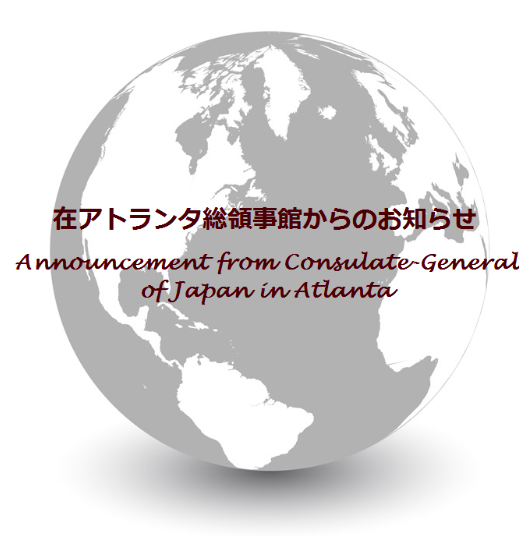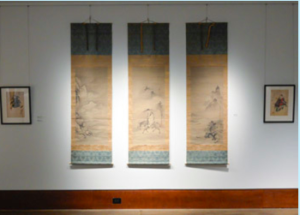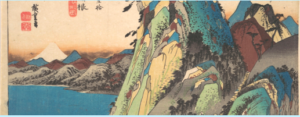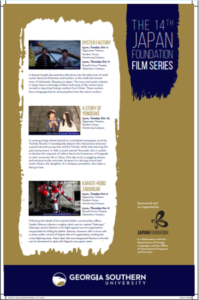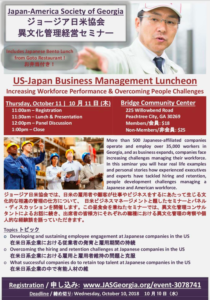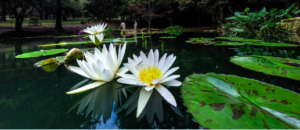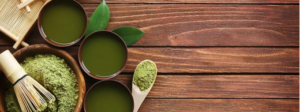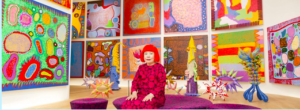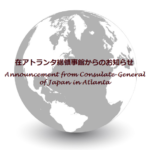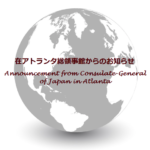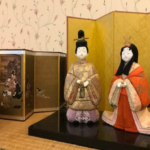芸術の秋!今回は秋にちなんでアートなお便りとご紹介です。ご興味のある方はぜひお出かけください。
Sonic Playground: Yuri Suzuki (Atlanta, GA)
When East Meets West: Three Centuries of Artistic Discourse (Atlanta, GA)
Japanese Art of the Edo and Meiji Eras (Spartanburg, SC)
“Going West to Find the East”: Japanese Architect Ito Chuta’s Travels Throughout the Ottoman Empire and His Thought on Oriental/Toyo Architecture (Chapel Hill, NC)
Japanese Printmaking: History, Techniques and Motifs (Spartanburg, SC)
The 14th Japan Foundation Film Series (Statesboro, GA & Savannah, GA)
U.S.-Japan Intercultural Business Management Luncheon (Peachtree City, GA)
Japanese Maples Celebration (Ball Ground, GA)
Japanese Tea Ceremony Demonstration (Spartanburg, SC)
Yayoi Kusama: Infinity Mirrors (Atlanta, GA)
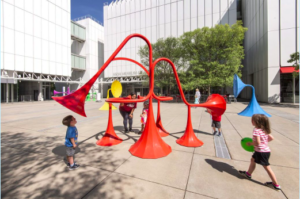
Sonic Playground: Yuri Suzuki (Atlanta, GA)
July 12 – October 7, 2018
High Museum of Art
1280 Peachtree St NE
Atlanta, GA 30309
High Museum of Art
1280 Peachtree St NE
Atlanta, GA 30309
Presented on the High’s outdoor Sifly Piazza, this installation by internationally renowned designer Yuri Suzuki features ingenious, colorful sculptures that modify and transmit sound in unusual, engaging and playful ways.
Sonic Playground continues the High’s multiyear initiative to animate its outdoor space with commissions that engage visitors in participatory art experiences. It is the High’s first venture into exploring the notion of audible play—how the sounds all around us can be constructed, altered and experienced. The installation transforms the piazza into a welcoming atmosphere for socializing and recreation and serves as a stage for performances and art-making activities the High is co-organizing with local arts organizations.
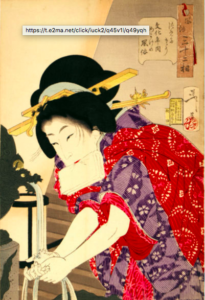
When East Meets West: Three Centuries of Artistic Discourse (Atlanta, GA)
September 28 – December 9, 2018
Oglethorpe University Museum of Art
4 Lowry Hall, 3rd Floor
4484 Peachtree Rd NE
Atlanta, GA 30319
Oglethorpe University Museum of Art
4 Lowry Hall, 3rd Floor
4484 Peachtree Rd NE
Atlanta, GA 30319
MEMBERS’ PREVIEW: Thursday, September 27, 6 – 8 p.m.; remarks at 7 p.m.
This exhibition will illustrate the rich cross-cultural influences between Japan and European and American artists from the late 17th to late 19th century. Prized works of Japanese porcelain dominated the decorative arts markets in Europe leading to the eventual creation of porcelain factories in Europe—most notably Meissen established under the patronage of Augustus the Strong of Saxony in 1710. Early Meissen wares sought to imitate the form and decoration of Japanese Arita and Kakiemon wares so prized by princely and aristocratic collectors in Germany, France and England in the 18th century.
When East Meets West will include numerous examples of late 17th and early 18th century Japanese porcelain from the John Lesh Jacobs Collection drawn from the permanent collections of OUMA and the High Museum. These works will be juxtaposed against exquisite examples of 18th century Meissen porcelain from the Warda Stout Collection borrowed from the Dixon Gallery and Gardens.
European and American artists of the 19th century artists would continue to draw inspiration from 18th and 19th century Japanese woodblock prints which began pouring into Europe in the 1860s ending years of Japanese isolationism. The group later to be known as the Impressionists would be profoundly influenced by such prints. The second half of the exhibition will contain 19th century works on paper by Japanese artists to include Hokusai, Utamaro and Hiroshege as well as Impressionist masterpieces by Pissarro, Boudin, Cézanne, Cassatt, Homer and Reid from the permanent collections of OUMA and institutional and private collections.
October – December 20, 2018
Richardson Family Art Museum
130 Memorial Dr
Spartanburg, SC 29303
Richardson Family Art Museum
130 Memorial Dr
Spartanburg, SC 29303
Japanese Art of the Edo and Meiji Eras (1603-1912) displays a variety of cultural expressions of Japan, including tea ceremony implements, woodblock prints, porcelains, and ink paintings. The Edo Period (1603-1868), named after the Shogun capital, is one of the most prosperous and thriving in the history of Japanese art. The political stability established by the Tokugawa family prompted an increase in artistic, cultural and social development, with flourishing and distinctive aesthetics represented in paintings, ceramics, woodblock prints and decorative arts. The Meiji Period (1868-1912), an era of radical social and political change from feudalism to modernity and adopted Western influences, witnessed a blending of cultures and an innovative interchange of old ideas and new in Japanese art. This exhibition intends to further enhance scholarly research for students in ARTH 322 Art of Japan, and several of the labels in this exhibition will be written by students. This exhibit runs through Thursday, December 20th.
Featured works are loaned from the Shiro Kuma Collection of Edwin and Rhena Symmes in Atlanta, GA, from the Edmund Daniel Kinzinger (1888-1963) Collection of Japanese Prints loaned by David and Barbara Goist in Asheville, NC, and from the collection of Dr. and Mrs. Hunter Stokes (’60) in Florence, SC.
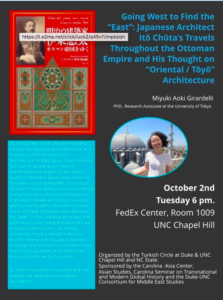 “Going West to Find the East”: Japanese Architect Ito Chuta’s Travels Throughout the Ottoman Empire and His Thought on Oriental/Toyo Architecture (Chapel Hill, NC)
“Going West to Find the East”: Japanese Architect Ito Chuta’s Travels Throughout the Ottoman Empire and His Thought on Oriental/Toyo Architecture (Chapel Hill, NC)October 2, 2018 6:00 – 7:30 pm
UNC Chapel Hill FedEx Center, Room 1009
301 Pittsboro St.
Chapel Hill, NC 27599
UNC Chapel Hill FedEx Center, Room 1009
301 Pittsboro St.
Chapel Hill, NC 27599
Ito Chuta (1867-1954), the architect who created the Japanese word “Kenchiku” as a translation of the English word “architecture” in Meiji Japan, is also the first historian of Japanese architecture. Searching for the origins of the Horyu-ji Buddhist Temple in Nara, today known as the oldest surviving wooden structure on the earth, Chuta came to construct a theory stating that the architecture of Horyu-ji is originated in Greek architecture via India, where some Buddhist monuments show traces of Greek influences after Alexander the Great. Chuta’s standing point was that both Horyu-ji and Greek architecture have enthasis in the columns. His theory, connecting Horyu-ji Temple in Nara to Ancient Greece, was actually a Japanese challenge and reaction to Euro-Centric and hierarchical paradigm of “Architectural” history constructed by Europeans.
Dr. Aoki conducted this research with the support she received from Graham Foundation.
October 4, 2018 4:00 pm
Wofford College – Leonard Auditorium, Main Building
429 N Church St
Spartanburg, SC 29303
Wofford College – Leonard Auditorium, Main Building
429 N Church St
Spartanburg, SC 29303
Join the Wofford College Art and Art History Department for this special lecture on the art of Japanese printmaking. This lecture, given by Dr. Marks, curator of Japanese and Korean art and director of the Clark Center at the Minneapolis Institute of Art, will provide an introduction and overview into Japanese woodblock prints (commonly called ukiyo-e) from the 17th to 19th centuries. Dr. Marks has also authored several books on the subject.
Arguably the most recognizable of all Japanese art forms, ukiyo-e have spread over the world and increased in popularity beyond the islands of Japan. Works like Hokusai’s “Great Wave”, “Large Head Beauties” by Utamaro and “Striking Actors” by Sharaku were all produced with the same techniques, as were hundreds of thousands of other designs.
Participants will learn about the production process, as well as print collecting-both then and now. This event is free and open to the public.
This lecture is in conjunction with current exhibit “Japanese Art of the Edo and Meiji Eras (1603-1912)” at the Richardson Family Art Museum, lower level.
The 14th Japan Foundation Film Series (Statesboro, GA & Savannah, GA)
October 9, 2018 5:00 pm
Ogeechee Theatre, Student Union
Georgia Southern University – Armstrong Campus
11935 Abercorn St
Savannah, GA 31419
Ogeechee Theatre, Student Union
Georgia Southern University – Armstrong Campus
11935 Abercorn St
Savannah, GA 31419
October 11, 2018 5:00 pm
Russell Union Theater
Georgia Southern University – Statesboro Campus
1332 Southern Dr
Statesboro, GA 30458
Russell Union Theater
Georgia Southern University – Statesboro Campus
1332 Southern Dr
Statesboro, GA 30458
A feature length documentary that dives into the daily lives of small oyster factories fishermen and worker in the small and remote town of Ushimado, Okayama in Japan. The town and oyster industry in Japan faces a shortage of labor and some of the owners have turned to importing foreign workers from China. These workers face a language barrier and prejudice from the native workers.
October 23, 2018 5:00 pm
Ogeechee Theatre, Student Union
Georgia Southern University – Armstrong Campus
11935 Abercorn St
Savannah, GA 31419
Ogeechee Theatre, Student Union
Georgia Southern University – Armstrong Campus
11935 Abercorn St
Savannah, GA 31419
A coming-of-age drama based on a serialized newspaper novel by Yoshida Shuichi. It nostalgically depicts the interaction between a good-natured young man and his friends, while interweaving the past and present. In 1987, a youth named Yonosuke who is unable to decline the requests of others leaves his hometown of Nagasaki to start university life in Tokyo. One day as he is juggling classes and extracurricular activities, he goes to a driving school and meets Shoko, the daughter of a company president, who takes a liking to him.
U.S.-Japan Intercultural Business Management Luncheon
(Peachtree City, GA)
(Peachtree City, GA)
October 11, 2018 11:00 am – 1:00 pm
Bridge Community Center
225 Willowbend Rd
Peachtree City, GA 30269
Bridge Community Center
225 Willowbend Rd
Peachtree City, GA 30269
More than 500 Japan-affiliated companies operate and employover 35,000 workers in Georgia, and as business expands, companies face increasing challenges managing their workforce. In this seminar you will hear real life examples and personal stories how experienced executives and experts have tackled hiring and retention, people development challenges managing a Japanese and American workforce.
Registration
- Members – $18.00
- Non-Members – $25.00
- Partnering Guest of JASG – $18.00
Japanese Maples Celebration (Ball Ground, GA)
October 27, 2018 9:00 am – 5:00 pm
Gibbs Gardens
1987 Gibbs Dr,
Ball Ground, GA 30107
Gibbs Gardens
1987 Gibbs Dr,
Ball Ground, GA 30107
Join us as we celebrate the beginning of the Japanese Maples ColorFest when Mother Nature paints the Gardens in golds,reds, oranges and burgundies with the Japaneses Maples as the stars.
Mother Natures canvas is the entertainment, view this wonderful work of art before it disappears until next year.
From Oct. 28 thru the month of November over 2000 Japanese Maples (150 varieties) will come alive in brilliant shades of red, gold, burgundy and yellow.
The colors will change from week to week and you will want to plan to visit often to see the ever-changing autumn landscape.
Japanese Tea Ceremony Demonstration (Spartanburg, SC)
November 1, 2018 4:00 pm
Richardson Family Art Museum
130 Memorial Dr
Spartanburg, SC 29303
Richardson Family Art Museum
130 Memorial Dr
Spartanburg, SC 29303
This traditional Japanese Tea Ceremony demonstration at Wofford College is presented by The Richardson Family Art Museum, The Department of Art and Art History, and The Asian Studies Program.
The tea ceremony is a long-lasting tradition in Japanese culture inspired by practices in Zen Buddhism. Matcha, powdered Japanese green tea, will be prepared and presented in a highly choreographed and organized manner.
Everyone will be welcome to taste the traditional Japanese green tea after the demonstration. This event, sponsored by the Cultural Affairs Committee, is free and open to the public.
Thursday, November 1, 4 pm at Richardson Family Art Museum (lower level), Rosalind Sallenger Richardson Center for the Arts.
Banzaicon (Columbia, SC)
November 2-3, 2018
Columbia Metropolitan Convention Center
1101 Lincoln St
Columbia, SC 29201
Columbia Metropolitan Convention Center
1101 Lincoln St
Columbia, SC 29201
Banzaicon is a Japanese Animation and gaming convention located in South Carolina. Banzaicon will be held November 2nd – 4th 2018 at the Columbia Metropolitan Convention Center.
Yayoi Kusama: Infinity Mirrors (Atlanta, GA)
November 18, 2018 – February 17, 2019
High Museum of Art
1280 Peachtree St NE
Atlanta, GA 30309
High Museum of Art
1280 Peachtree St NE
Atlanta, GA 30309
The High is proud to present the most comprehensive exhibition by Yayoi Kusama (Japanese, born 1929)—one of the twentieth century’s most influential artists—to tour North America in over twenty years.
Organized by the Hirshhorn Museum and Sculpture Garden, this show will take visitors on an expansive journey across six decades of Kusama’s creative output and will explore the development of the artist’s Infinity Mirror Rooms, her iconic, kaleidoscopic environments. The exhibition will present six of these rooms as well as sculptures, paintings, works on paper, film excerpts, archival ephemera, and additional large-scale installations that span the early 1950s to the present day. Also on view will be numerous new works by the 89-year-old artist, who remains active in her Tokyo studio.

